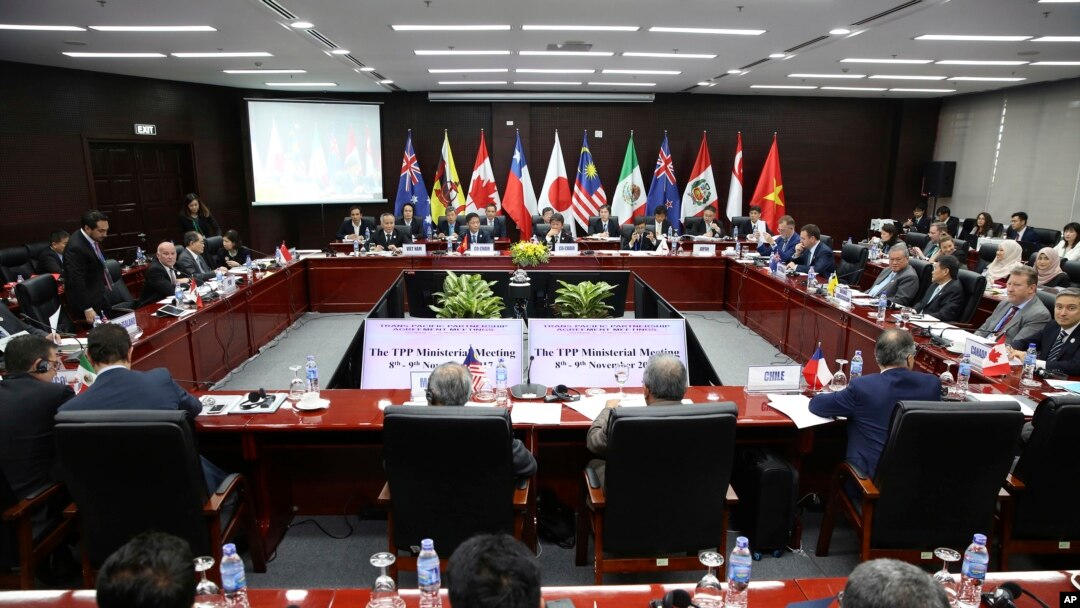Trade ministers of the remaining 11 countries of the expansive Pacific Rim trade pact abandoned by U.S. President Donald Trump reached a deal early Saturday to salvage the agreement without participation by the United States.
Previously known as the Trans Pacific Partnership (TPP), it now will be known as the Comprehensive and Progressive Agreement for Trans-Pacific Partnership (CPTPP).
“Ministers are pleased to announce that they have agreed on the core elements of the Comprehensive and Progressive Agreement for Trans-Pacific Partnership,” the 11 nations said in a statement.
Setback for US
“It’s a huge setback for the United States,” according to Deborah Elms, executive director of the Singapore-based Asian Trade Center. “If you are an exporter this is deeply damaging.”
Elms said that while some large U.S. corporations might find alternative ways, with their global networks and subsidiaries, to take advantage of the CPTPP through their global networks, America’s smaller agricultural entities look to suffer the most damage, especially those in the dairy, beef and pork sectors who would have benefited from significantly greater access to the Japan market.
“Australia, New Zealand and Canada will suck up that new access,” said Elms, who was in Danang for APEC business and trade meetings.
“When Trump abdicated TPP and then told regional nations to go on their own as the U.S. would, it was inevitable that a new formulation of TPP would emerge not only without American leadership, but also without even an American presence,” said former U.S. Ambassador to the Asian Development Bank, Robert “Skipp” Orr.
“U.S. economic interests will have to contend with the consequences of such shortsightedness,” Orr, an Obama appointee who previously was president of aircraft maker Boeing in Japan, told VOA.

Vietnam's Industry and Trade Minister Tran Tuan Anh, left, and Japan's Minister of Economic Revitalization Toshimitsu Motegi shake hands after a news conference on the Trans Pacific Partnership (TPP) Ministerial Meeting during APEC 2017 in Danang, Vietnam
Opponents of the TPP have criticized it for putting corporate interests over those of workers, and it became a campaign issue during the 2016 presidential election in the United States, with Democratic Party candidate and former Secretary of State Hillary Clinton, who lost to Trump, reversing her previous support of it.
Trade deal reboot
On the eve of the leader’s summit of APEC, the forum for 21 Pacific Rim countries to promote free trade, trade ministers scrambled to complete the rebooted trade deal for their bosses.
A last-minute disagreement between Canada and Japan resulted in some drama, with Canadian Prime Minister Justin Trudeau not showing up for a meeting of the 11 remaining TPP countries, prompting its postponement.
Eventually the issue was resolved, leading to an announcement that the refashioned agreement will maintain “the high standards, overall balance and integrity of the TPP while ensuring the commercial and other interests of all participants and preserving our inherent right to regulate, including the flexibility of the parties to set legislative and regulatory priorities,” according to the ministers’ statement.
WATCH: Leaders of US and China Offer Asia Business Leaders Divergent Paths
Your browser doesn’t support HTML5
Leaders of US and China Offer Asia Business Leaders Divergent Paths
Trump: No multilateral agreements
Trump, in a Friday speech to APEC business executives, reiterated his opposition to multinational trade agreements but expressed willingness to negotiate with any country in the region for one-on-one trade deals.
The final text and schedules of the CPTPP have not been released, but it is expected to be signed by leaders in January or February 2018 and entering into force before the end of next year.
The TPP, led by Trump’s predecessor, Barack Obama, and Japanese Prime Minister Shinzo Abe, was the largest trade agreement in history when it was signed in February 2016. It was intended to create new market opportunities for companies and was touted to realize significant cost savings for corporations and consumers.
The World Bank had forecast the original agreement itself could see GDP rising by an average of more than 1 percent by 2030 and increase member countries’ trade by 11 percent by the same year.
The TPP was a centerpiece of the Obama administration’s “Pivot to Asia” and was seen as helping the United States, which is the world’s largest economy, lead other countries in a strategic bulwark to temper a rising China, the world’s No. 2 economy.


